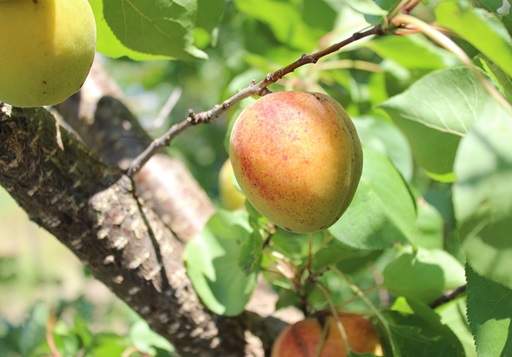How to Grow Your Own Apricot Tree
Apricots are a rewarding fruit to grow, being relatively undemanding apart from feed and water and producing a delicious tasting fruit packed will juice that provides fibre, antioxidants, vitamins and minerals. Fruits grown organically and eaten fresh from the tree are better and much sweeter than anything that can be bought from the shelves of supermarkets. Apricot trees can be planted from September to May and, as they are self-fertile, crop with a single tree. The fruit can be canned, dried, eaten fresh, cooked or even used to make wine.
Recommended Variety
Apricot Moorpark- the most commonly grown apricot in the UK, and probably the most reliable. Fragrant pink blossoms appear in spring, followed by the leaves, then juicy fruit, ripening in August. Plant in full sun in a sheltered spot or a container. Self-fertile.

Pollination & Fruiting
Apricot blossom is self-fertile, but it helps to hand pollinate your apricot tree with a small brush during blossom time if you're able to. It is sometimes a good idea to thin the fruit at regular intervals, removing poor quality, misshapen or unhealthy fruits when they are the size of cherries. If any cluster contains more than 3-4 apricots, remove the smallest/weakest to allow the others to reach full maturity. Apricots are normally ready for harvesting from midsummer through to early autumn, when they are fully coloured and the skin gives slightly when pressed. Be gentle when picking to avoid breaking the skin of the fruit.

Apricots are ready to be harvested when they are fully coloured and the skin gives gently when pressed
Planting Advice
Containerised apricot trees are best planted in either September or May, rather than the depths of winter. Bare root trees can be planted in winter, but ensure the roots are protected from freezing with a mulch. All apricot trees are best grown in a warm, sheltered sunny site in a deep, moist yet well-drained soil, ideally slightly alkaline. Trees grown next to a south-facing wall have the benefit of extra protection but will blossom earlier as a result. Growing apricot trees in a east-facing location or north slope is sometimes the better option because it provides a balance between some shelter from prevailing winds whilst not prompting early blossoming and the frost exposure issues that come with it. If the tree is grafted, position the inside of the curve of the graft union away from the afternoon sun. Mix in a generous amount of well-rotted organic matter when planting, then stake and secure with a tree tie.

Stake your apricot tree to keep it secure in windy conditions
Apricot Plant Care
Water newly-planted trees thoroughly every week as they establish in their first spring and summer; this is particularly important as fruits start to develop. Do not over-water (daily watering is not required) as this can result in root rot. Whilst apricot trees are fully hardy, they flower early, making them vulnerable to frost. Cover with horticultural fleece or clear polythene supported above the tree using a frame or bamboo canes, to protect the blossoms from frost on colder nights, ensuring the fleece or polythene does not touch the flowers. Containerised specimens should be moved to a shed or cold greenhouse when frost is expected.
Feed with multipurpose plant food in late February, then prune in spring or between late July and late August. The aim of pruning is to maintain an open shape that allows good air movement and sun penetration through the tree with minimal pruning. You should aim for a goblet-shaped tree with an open middle as this will allow the sun and air in most effectively. Apricot trees crop most abundantly on 2 to 3 year old wood, so don't prune extensively or you will get a poor crop. Prune very lightly (if at all) for the first few years. Thereafter, cut older shoots out every 4 to 6 years to make way for new shoots, selecting those that are no longer fruiting. Apricot trees are very responsive to being grown fan-trained against a wall. If this is an option you want to pursue, plant 15cm (6") away from your chosen wall or fence and prune in early spring, before the growth begins, cutting back the leaders to encourage a more fan-shaped growth habit.

Apply a slow-release, multi-purpose plant food to your apricot tree every February
Share this page:


